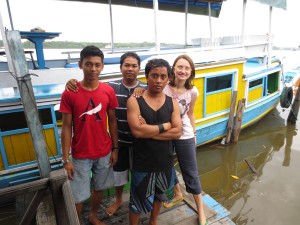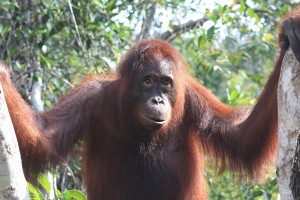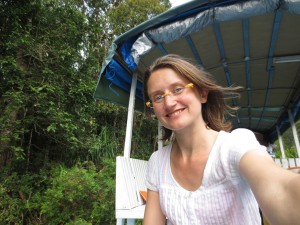Tanjung Park
Tanjung National Park in the Indonesian Borneo was a worth-while detour. I had read an article about the park online and immediately felt that I had to go.
Going to Pangkalanbun from Bali was not that easy. It required three different flights that I booked with two airlines. I was very nervous about missing my connection and indeed my first flight was 30min delayed. So now I only had 40min to get my bag, check in again and make my next flight. Luckily, I found that people all over Indonesia are very nice to Westerners. So as soon as I explained my situation to a guard, he made sure to bring me to the right counter and take care of my bags. I was the last person to board the plane.
Kalimatan, the Indonesian side of Borneo, is not very touristy. I understood that immediately when I was handed a hand-written boarding pass and told to just walk to the right airplane on the runway. I felt that this is how flying should be. No one checked my bags, I could easily walk to my plane that was clearly labeled. No hassle, no waiting, just like taking the train! The flight also had multiple stops and I just got off at the one I wanted. I love it!
Another hilarious feature of Kalimatan computer systems is that they limit the number of characters a name can have to 15. My first and last name sum up to 16 characters. This led to a lot of confusion as people were debating how to deal with my name, but in the end they just decided that “Floraine” should be spelled as “Florain”. After all, the “e” isn’t pronounced…
The Pangkalanbun airport is a tiny little airport. My per-arranged guide picked me up from the airport and drove me to the port in Kumai. In Kumai, I boarded my cute little houseboat where I would be for the next three days. I really loved my boat. The lower part was for the crew (captain, assistant captain and guide) and the upper part was for me. I had a dining table, two beds and a bench in front of the boat from where I could enjoy the view.
 My crew consisted of three boys who were all very sweet. They looked like teenagers, but were actually just a few years younger than me. They took really great care of me and were very respectful and polite. The guide was the person who spoke English the best, but he had only started to learn it one month before. Like many Indonesians, he learned English by studying an English-Indonesian dictionary.
My crew consisted of three boys who were all very sweet. They looked like teenagers, but were actually just a few years younger than me. They took really great care of me and were very respectful and polite. The guide was the person who spoke English the best, but he had only started to learn it one month before. Like many Indonesians, he learned English by studying an English-Indonesian dictionary.
The meals on my boat were always excellent and I was consistently served way too much food. I did not have a cook on my boat, but another boat from the same company shared their cook with me. So the first day when I arrived, I was served a big lunch and off we went. The boat first went down a very large river and then took a turn into the Tanjung park. On the large river, I saw many oil companies. Apparently, there is a big oil, sand and gold industry in the area. Sadly, the pollution caused by all of this made the river water brown.
Regardless, I enjoyed the exotic scenery and the whole boat experience felt very special. The further we went down the river, the smaller it became and the deeper we entered the jungle. The scenery changed and palm trees were replaced by high rainforest trees filled with monkeys. We made our first stop at 3pm at the orangutan feeding station.
There are about 5000 orangutans living in the Tanjung park. Some of them were born in that area, others were released there after spending some time in a rehabilitation center. The palm tree oil business is a very sad business. Palm tree oil is the 2nd most used vegetable oil in the world and almost all of it comes from Indonesia and Malaysia. I only recently realized this, but palm tree oil is really everywhere whether you want it or not: cereals, chocolate, body lotions etc. As a consequence, a lot of rainforest is burnt down in Borneo to plant palm trees. Sadly, many orangutans get trapped in the fire and those that survive loose their homes. The government only recently built a number of rehabilitation centers for orangutans. After spending some time in the center, they are released into the Tanjung park or other nearby parks.
 The orangutans live wildly in the park. But to take advantage of tourism, they put bananas at certain places at specific times. This way, some orangutans will come to take the bananas and tourists will get to see them from a close distance. The first station is perhaps the least famous one, but I also thought it was the best station. We saw lots of orangutans and even saw three different males. The males are very large and impressive. The first station is also a good station for tourists in the sense that orangutans don’t have that much food in the forest. This means that they really like the bananas that are left for them. On the way back to the boat, I got to see one more big male just sitting a meter from the path.
The orangutans live wildly in the park. But to take advantage of tourism, they put bananas at certain places at specific times. This way, some orangutans will come to take the bananas and tourists will get to see them from a close distance. The first station is perhaps the least famous one, but I also thought it was the best station. We saw lots of orangutans and even saw three different males. The males are very large and impressive. The first station is also a good station for tourists in the sense that orangutans don’t have that much food in the forest. This means that they really like the bananas that are left for them. On the way back to the boat, I got to see one more big male just sitting a meter from the path.
After the first station, we took the boat deeper into the jungle. I had dinner and soon afterwards, we all went to bed. There wasn’t really much else to do on the boat since there was no electricity and no light except from the two candles. It was fun to sleep in the jungle. I definitely could hear all sorts of monkey and other noises nearby. I also got woken up at some point in the night by two orangutans fighting. Obviously, I couldn’t see them, but I definitely could hear them.
On the second day, we took the boat to two more feeding stations. Both had way fewer orangutans than the first one. The rangers told us that orangutans have enough forest food to eat here and don’t care about the feeding times as much. The last station was Camp Leaky. It is quite a famous station in the sense that a lot of research is done there. There are also mostly rehabilitated orangutans there instead of wild ones. This means that they are very comfortable with humans. On the way back to the boat, we saw several orangutans just sitting along the path and the senior guides interacted and played with them. Most orangutans live up to 50 years and sometimes even longer. So the guides can definitely establish a relationship with them over the years.
 Camp Leaky is one of the places where the river has clear (instead of brown) water. My crew seemed really proud of the clear water and insisted that they set up the shower in the bathroom. The shower basically pumps up water from the river. It was very funny how they wanted to provide “Western standards” on the boat and were delighted when I used their shower.
Camp Leaky is one of the places where the river has clear (instead of brown) water. My crew seemed really proud of the clear water and insisted that they set up the shower in the bathroom. The shower basically pumps up water from the river. It was very funny how they wanted to provide “Western standards” on the boat and were delighted when I used their shower.
After Camp Leaky, we took the boat back to the beginning of the park. The whole river is known to have many crocodiles in it. And indeed, we saw two crocodiles. One of them was even hunting which was very impressive. Next to the crocodiles, there were some brave locals peacefully picking palm leaves as if there was nothing to worry about.
When driving the boat at night, we saw hundreds of fireflies in the nearby trees along the river. It was a beautiful sight and the crew joked that it was like Christmas. We slept one more night on the boat at the entrance of the park. The next morning, we went back to Kumai. I was slightly disappointed that we went back to Kumai this early. My understanding was that I payed for a three day, two nights tour. But there was some misunderstanding between the guide and the manager. I made it clear that I was unhappy about it, so the manager, Jenie, told me he would give me a city tour later in the afternoon.
Jenie is a really nice guy and was actually supposed to be my guide. But his tour company has become so popular that he can’t be the guide for all of the tours anymore. He is a bit of a monkey man himself and spent months with the orangutans. He had lots of good stories and pictures of orangutans imitating him and even washing his clothes. Jenie invited me to his house. I went to the local market with his wife to buy lunch and hung out in his garden. We all had lunch sitting on the floor and eating with our hands. It was a fun experience to see how locals live.

He then took me on a small canoe to see the city of Pangkalanbun. He kept telling me how beautiful the houses along the river are. It’s true that the houses were built of ironwood which is a very solid and expensive type of wood. However, I found myself a bit shocked to see how poor people are in that area. People were washing and bathing in brown polluted river water. Their houses were falling apart and every house had a little shack directly on the river that they use as toilets. I have certainly seen poverty before in Africa and India, but Pangkalanbun really shocked me, perhaps because I didn’t expect it.
What was particularly sad was to see all of these big Chinese and Indian oil/sand/gold companies just down the river. Lots of money must come from that. But people told me that everything is so corrupt, that the locals don’t see any of the money. All they get out of it is the brown river water. Given this level of poverty, it’s impossible to blame the locals for illegally renting their rainforest land to the palm tree oil industry. This is a big problem for the animals and also for the land. Palm trees render the land infertile even after the plantation is gone… People, including Jenie, are not very optimistic about the situation and worry about the environment, the animals, and the local population.
I spent a lot of time with Jenie and his wife until the next day and it was really interesting to hear about what is going on in Indonesia. The next day, Jenie brought me to the airport on his little scooter. It was quite a challenge to stabilize my big bags on the bike. Luckily, the airport wasn’t far away. From the plane, I got to see first-hand how a lot of rainforest was being cut down and burnt. It was a sad sight…
This concludes my trip to Indonesia. I flew to Pontianak and then took a bus to Kuching which is on the Malaysian side of Borneo. I really loved Indonesia and would recommend this place to anyone. It is touristy enough to make travel very easy, but still feels exotic. The people were all incredibly friendly and helpful. Even in the poorest parts of Pangkalabun, they were very excited to see Westerners and were proud to show them around. Indonesia is also so diverse that whatever you are looking for: hikes, relaxing beaches, interesting cities, etc. , you will find it on one of the Indonesian islands. It was really a fantastic country to start my trip with!
More pictures can be found here.
Practical Information: In the high season, you’ll need to book your jungle trip at least a month ahead of time. I can highly recommend the family business of Jenie (jeniesubaru@gmail.com). It’s one of the few local businesses (most other tour operators are owned by Australians or people from Java), so it’s a nice way to support the people in Pangkalanbun. However, be aware that when you book with Jenie, he might not actually be your guide. Make sure to ask Jenie beforehand who will be the guide. All of his brothers and his cousin Bobo are great. If it is someone else, ask about how senior that person is and how well that person speaks English. Also, confirm that the tour is indeed three full days long. A few things went wrong with my tour (only 2 days, guide wasn’t very experienced) and partially it was my fault for not confirming all the information with Jenie.
This entry was posted on Saturday, August 24th, 2013 at 3:29 pm and is filed under Travel Stories. You can follow any responses to this entry through the RSS 2.0 feed.




